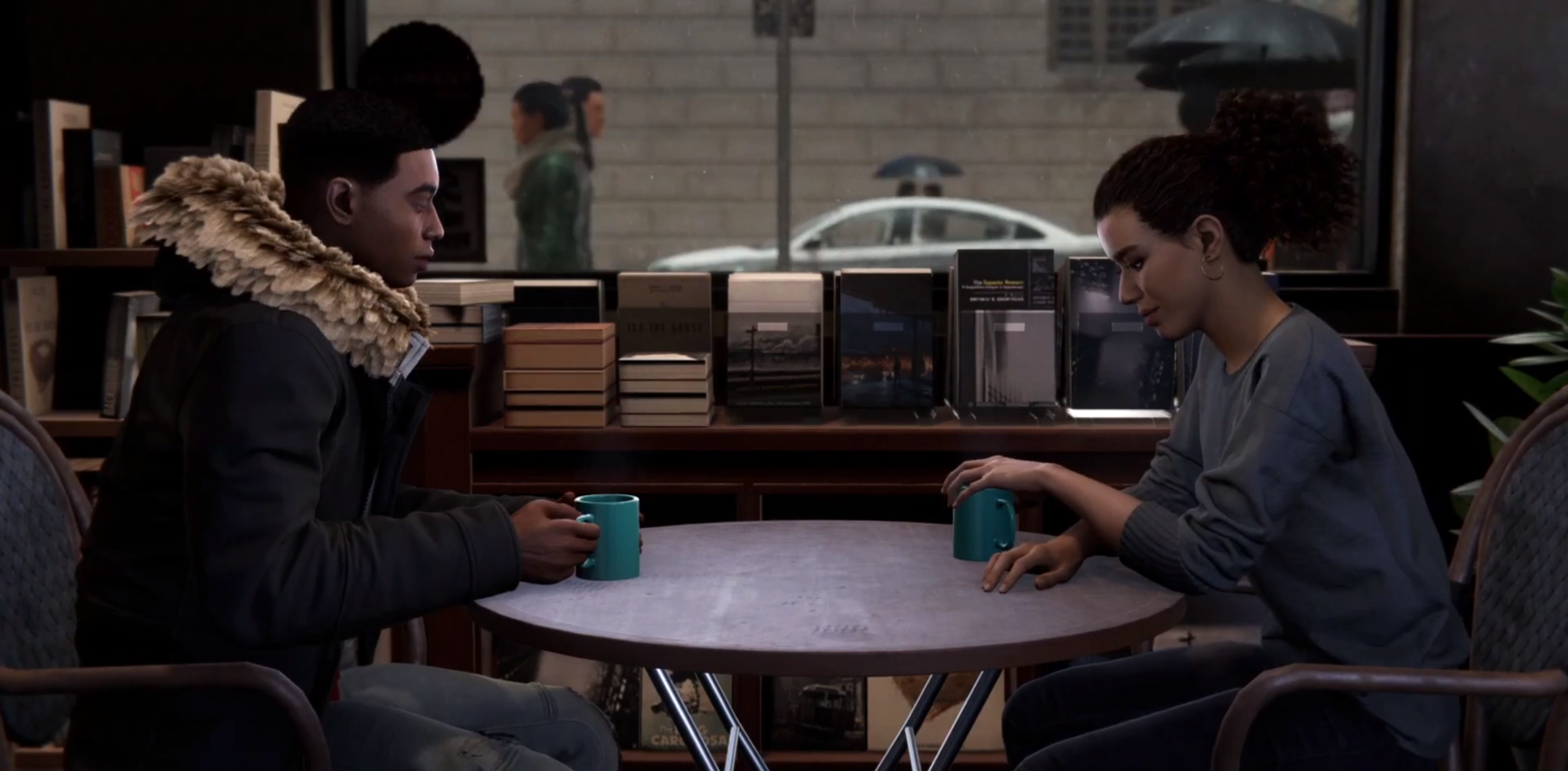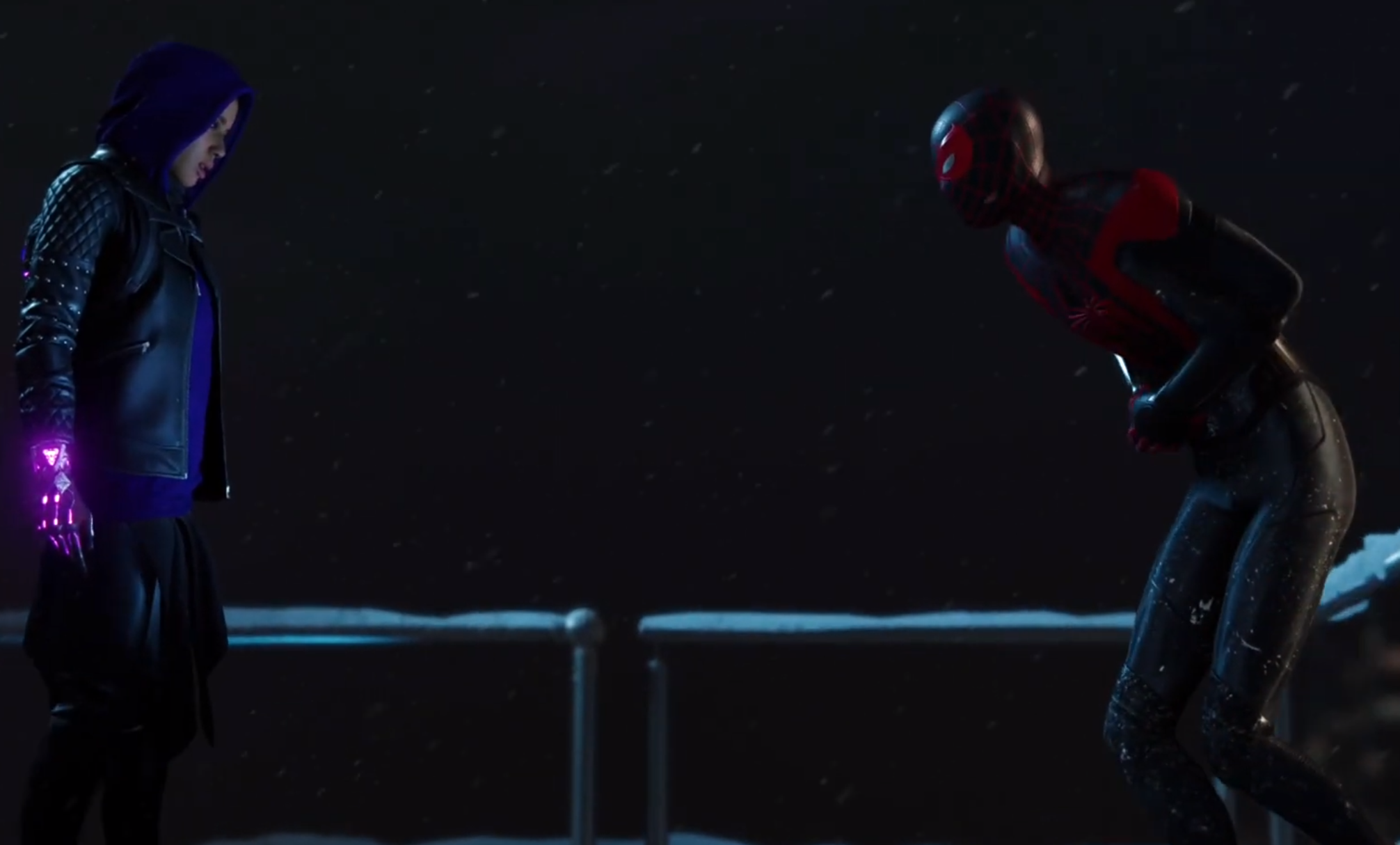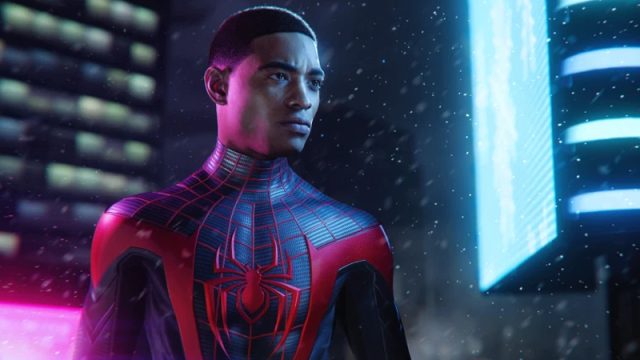Insomniac’s first thwip at the Spider-Verse gave us a compelling tale of Peter Parker’s dual life, with a wonderfully personable twist that smashed those halves together. Its successor — Spider-Man: Miles Morales, released last week — does the same but as its larger self does, the new story drills this idea down into something far more potent and intimate to Miles.

Very early on in Miles’ story, we’re introduced to the people closest to him in life. Although he’s absent for much of the game thanks to an impromptu reporting trip with Mary-Jane, there’s his mentor Peter, of course. There’s his best friend, Ganke, his confidante in all things Spider-Man, and his mother Rio, a source of strength after the loss of his father Jefferson during the events of the first game. A little after that, we’re also introduced to his uncle Aaron, a more distant relative and not just because of the bad history between Rio and Jeff. As Miles quickly learns, his uncle is the teched-out criminal vigilante Prowler.
All these interactions specifically feel like they capture the same sort of duality Peter’s relationship with Otto Octavius in the first game had (in this universe, Octavius is Peter’s scientific mentor before his fall from grace as the villainous Doc Ock). Rio is there to represent the will-they-won’t-they idea of someone close to Miles discovering his dual identity. Aaron, for the most part, offers that, as well as the wrench of someone in Miles’ personal circle interacting with his superheroic one. Ganke, if anything, feels like the freshest addition here — someone Miles can actually talk to about being who he really is, a potent reminder of just how lonely Peter’s life under the mask can be in comparison.

But they are not the most interesting dynamics Miles shares in his titular game. Early on as well we are introduced to another character in Miles’ personal orbit that the game leverages to create its most powerful story. A girl, the same age as Miles, and one of his closest lifelong friends: Phin Mason. Perhaps better known to diehard Spider-fans as Phineas Mason, the Tinkerer.
Unlike the dread, tragic inevitability of seeing Octavius in the earliest moments of Spider-Man, Phin’s first entrance into Miles Morales — a surprise guest for dinner on Christmas Eve at Miles and Rio’s new apartment in Harlem — is not shocking unless you know the ins-and-outs of Spider-Man lore. After all, in the comics, Phineas is male, and although the purple accents in her clothing might give away the connections to the purple hues of Miles Morales’ reinvention of the character as the technologically-enhanced leader of a new criminal faction known as the Underground, it’s not quite as immediately shocking as a set of Chekov’s Robo-Octopus Arms.
That means Miles Morales can’t lean on its audience being familiar with who Phin is in the comics as it could with Octavius. But it also means that the story told between Miles and Phin grows into something much more emotionally complex for the duo beyond “mentor gone bad.” Even before Miles finds out that Phin is the face of the Underground and the creator of its high-tech weaponry during an explosive battle on the Braithwaite Bridge, his relationship with her is fraught with a sense of frayed nerves and tension. They’re very close, but it’s also made clear that they’ve grown apart in recent years.

Phin had a brother, Rick (here a Roxxon employee vital to the technocratic corporations’ renewable energy push into Harlem), who was equally close with Miles. But Rick’s passing distanced the two — Miles going to one school, Phin to another, communication and time together fleeting, far from the shared lives they’d lived as younger teens. There’s a teenage awkwardness to their attempts to reconnect over the early parts of the game, dancing around each other on issues of trust, not just because both are hiding dual identities, but because the idea of re-opening those painful memories of why they drifted apart is still too much. It’s perhaps that issue which defines Miles Morales’ central conflict more than anything: not that Miles and Phin find themselves are on opposites sides of how to defeat Roxxon, but how the young teenagers process grief, and how trying to process that grief becomes a severe issue of communication.
As the story progresses, the barriers continue to grow between Phin and Miles, with Phin’s grief and anger proving especially difficult for her to tackle. Miles attempts to reach out to her — first acting as if he wants to join the Underground, then revealing himself as Spider-Man to her — aren’t seen as a friend reaching out, but abuses of trust, only pushing Phin further down her solitary path and away from his attempts to reconnect. Every time it feels like there’s a chance for the two to become as close as they were before Rick’s passing, they’re forced apart again: not by circumstance but because Phin actively chooses to push Miles away.

The frustration they each feel — at Roxxon, at each other, at themselves — makes Miles Morales’ story so much more intimate than the inevitability of Peter’s clash with Octavious, because we are granted so many chances to see just how close Miles and Phin are to reconciliation. There are moments they work together, as Tinkerer and Spider-Man, to push back against Roxxon’s reckless plan for control in Harlem. There are moments as friends, where they look back on the goofy science projects they worked on together, and wonder what was lost between them even before the superhero stuff got in the way.
It’s a quiet mourning that is layered into the game even beyond the narrative. In Spider-Man, Peter would find old backpacks containing memorabilia of his career as a hero, Easter Egg tributes to his long comic book history — an Aunt May recipe for wheat cakes here, a reference to an old clash with his rogue’s gallery there. In Miles Morales, those collectibles become time capsule lockboxes Miles and Phin left all over as kids, containing memories of their friendship. Each one found, another recollection, each one found, another regret at these lost moments, archived in time.

As Phin and Miles battle to save Harlem from Roxxon’s rapidly-destabilising energy reactor — destabilising in part because of Phin’s own sabotage of it, seeking vengeance for her brother’s death — there’s something mournful in the climax’s high-stakes spectacle. Theirs is a tragedy that feels altogether different from the one between Peter and Octavius. There, it was the spectre of inevitability, of destiny itself: that no matter how hard Peter fought it, Otto Octavius would have to become Doctor Octopus. Miles and Phin’s conflict is so much more fraught with the promise of what could’ve been because we are reminded constantly of what it once was.
We’re reminded that those moments are lost forever in the game’s closing moments, as Phin, finally opening herself back up to Miles long enough to realise what’s become of their conflict, makes a sacrifice. Propelling herself into the air with Miles’ broken body — rippling with the uncontainable energy he’s just absorbed to stop the reactor going critical and destroying Harlem — she comforts him, knowing the blast Miles is about to unwittingly unleash will kill her, but is far enough away to keep the borough and her friend from harm. In her final moments, she asks Miles to do what he’s been struggling against the whole game, what she has been as well: to let go.

In the last mission of Miles Morales, just before the big final fight between Phin and Miles, you play a flashback sequence — back to when Rick was alive, when things were right between these two friends, visiting their award-winning school science project as it’s shown off in a local Oscorp museum. As Phin and Miles wander the exhibits, trading friendly barbs and dancing around the fact that their young lives are about to change — not in the superheroic sense, but their incoming destinies at schools apart from each other — Miles accidentally bumps into some of the museum’s patrons, quickly apologising as he goes to catch up with Phin.
Although this younger Miles is yet to learn who it is, we are intimately aware: Peter Parker and Otto Octavius, friends, colleagues — their hurt so far ahead of them in this moment that we are given the chance to look back, one last time, at what was between them. Spider-Man: Miles Morales also asks of us to do the same for Phin and Miles but it’s bittersweet, the realisation that it did not have to be this way between them if only they’d had the chance to listen to each other, to get through and re-knit what was broken.
Instead, as Miles does, we have to let go, and leave what was behind.
